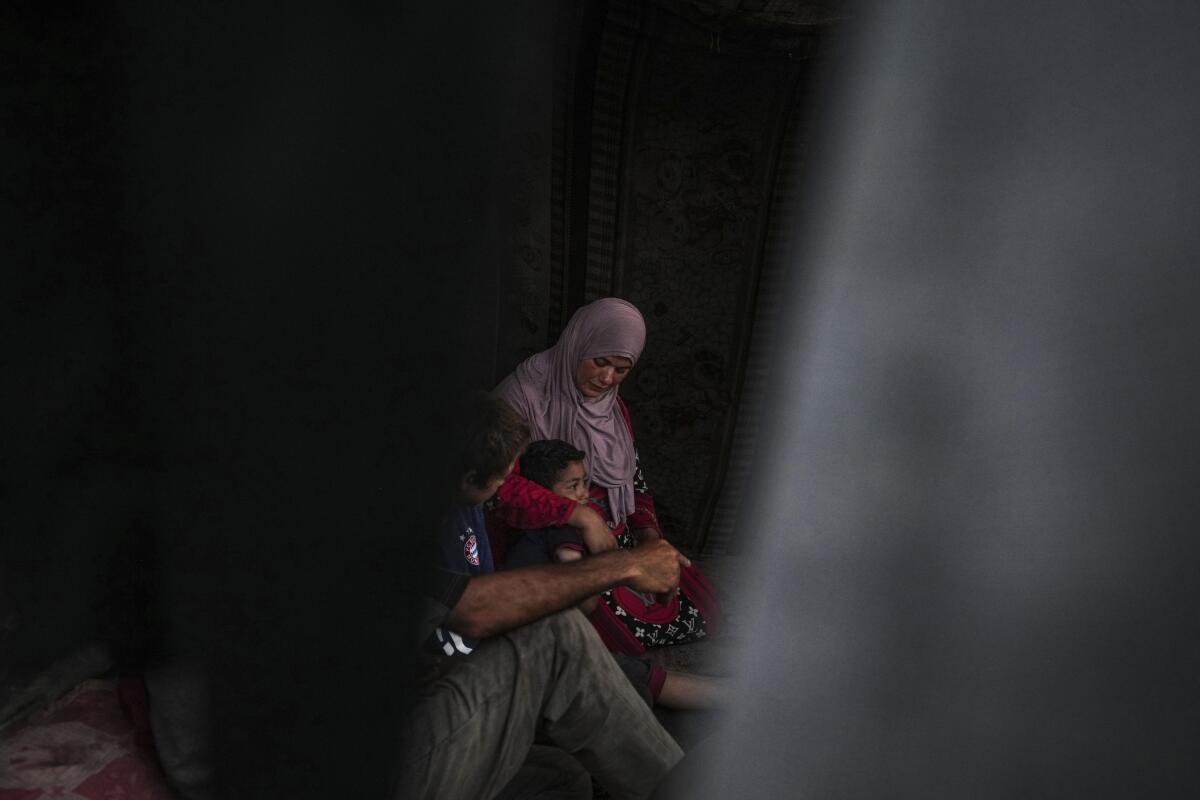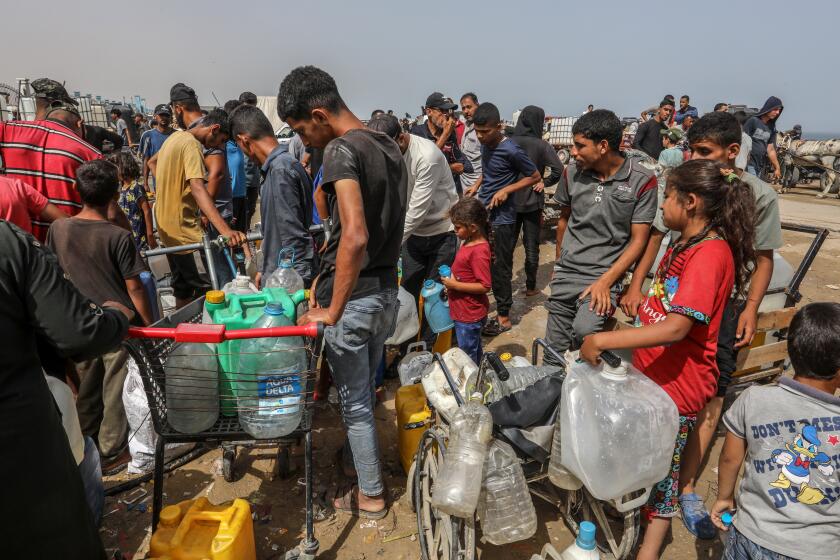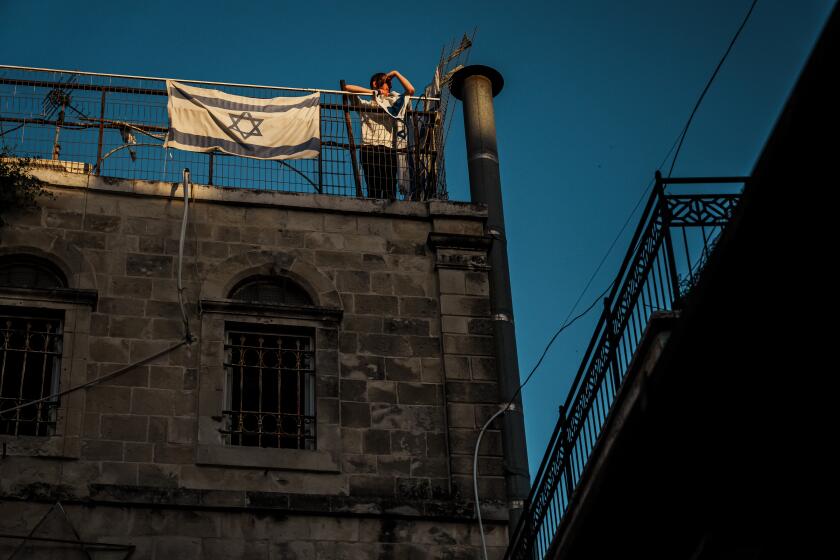A usually joyous Muslim holiday falls amid the ruins and hunger of Gaza

- Share via
DEIR AL BALAH, Gaza Strip — Last summer, Palestinians in the Gaza Strip celebrated the Muslim holiday of Eid al Adha the way it’s supposed to be: with large family feasts, meat shared with those less fortunate, and new clothes and gifts for children.
But this year, after eight months of devastating war between Israel and Hamas, many families will eat canned food in stifling tents. There’s hardly any meat or livestock at local markets, and no money for holiday treats or presents — only war, hunger and misery, with no end in sight.
“There is no Eid this year,” said Nadia Hamouda, whose daughter was killed in the war and who fled from her home in northern Gaza months ago and is staying in a tent in the central town of Deir al Balah. “When we hear the call to prayer, we cry over those we lost and the things we lost, and what has happened to us, and how we used to live before.”
Muslims around the world will celebrate the four-day Eid al Adha, the Feast of the Sacrifice, early in the week. It commemorates the Prophet Ibrahim’s willingness to sacrifice his son, Ismail, as recounted in the Quran. In the Jewish and Christian traditions, Abraham is called to sacrifice his other son, Isaac.
Gaza was impoverished and isolated even before the war, but people still managed to celebrate by hanging up colorful decorations, surprising children with treats and gifts, and purchasing meat or slaughtering livestock to share with those less fortunate.
“It was a real Eid,” Hamouda said. “Everyone was happy, including the children.”
Now much of Gaza is in ruins and most of the population of 2.3 million Palestinians have fled their homes. After Hamas’ surprise attack into Israel on Oct. 7, in which Palestinian militants killed some 1,200 people and took another 250 hostage, Israel launched a massive air and ground assault.
The war has killed over 36,000 Palestinians, according to Gaza’s Health Ministry. It has destroyed most of Gaza’s agriculture and food production, leaving people reliant on humanitarian aid that has been held up by Israeli restrictions and the ongoing fighting.
For months, extremist Israeli group Tzav 9 has been blocking lifesaving aid meant for Palestinians struggling to survive in the war-torn Gaza Strip, U.S. officials say.
United Nations agencies have warned that over a million people — nearly half the population — could experience the highest level of starvation in the coming weeks.
In early May, Egypt shut down its crossing into the southern Gazan city of Rafah after Israel captured the Palestinian side of it, sealing the only route for people to enter or leave the territory. That means virtually no Palestinians from Gaza will be able to make the annual Hajj pilgrimage that precedes the Eid.
Ashraf Sahwiel, who was among hundreds of thousands of Palestinians who fled from Gaza City earlier in the war and is also living in a tent, has no idea when or if he’ll be able to return.
“We don’t even know what happened to our houses or whether we’ll be able to live in them again, or if it’s even possible to rebuild,” he said.
Abdelsattar al Batsh said he and his family of seven haven’t eaten meat since the war began. Two pounds of meat costs around $50. A live sheep, which could be bought for as little as $200 before the war, now costs $1,300 — if it’s even available.
“Today, there is only war. No money. No work,” Al Batsh said. “Our houses have been destroyed. I have nothing.”
Iyad al Bayouk, who owns a now-shuttered cattle farm in southern Gaza, said severe shortages of both livestock and feed due to Israel’s blockade have driven up prices. Some local farms have been turned into shelters.
Mohammed Abdel Rahim, who has been sheltering in a building in an empty cattle farm in central Gaza for months, said the farm-turned-shelter was particularly bad in the winter, when it smelled like animals and was infested with bugs. As the heat set in, the ground dried out, making it more bearable, he said.
A comparison of Biden and Trump on Mideast policy. The biggest disparity between the two candidates may be their attitude toward Palestinians.
Abdelkarim Motawq, another displaced Palestinian from northern Gaza, used to work in the local meat industry, which did brisk business ahead of the holiday. This year, his family can only afford rice and beans.
“I wish I could work again,” he said. “It was a busy season for me, during which I would bring money home and buy food, clothing, nuts, and meat for my children. But today there’s nothing left.”
Associated Press writer Shurafa reported from Deir al Balah, Khaled from Cairo.
More to Read
Sign up for Essential California
The most important California stories and recommendations in your inbox every morning.
You may occasionally receive promotional content from the Los Angeles Times.











